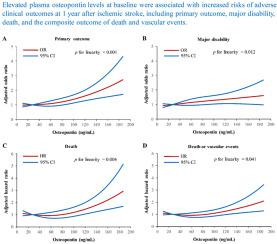Atherosclerosis ( IF 5.3 ) Pub Date : 2021-07-30 , DOI: 10.1016/j.atherosclerosis.2021.07.010 Zhengbao Zhu 1 , Yan He 2 , Mengyao Shi 3 , Daoxia Guo 2 , Kaixin Zhang 2 , Liyun Ren 3 , Yanbo Peng 4 , Pinni Yang 2 , Jing Chen 5 , Yuhan Zang 2 , Aili Wang 2 , Tan Xu 2 , Qunwei Li 6 , Zhong Ju 7 , Deqin Geng 8 , Yonghong Zhang 2 , Jiang He 5

|
Background and aims
Osteopontin is implicated in atherosclerosis, and its expression is upregulated in response to brain injury. The aim of this study was to prospectively investigate the associations between plasma osteopontin levels and adverse clinical outcomes in ischemic stroke patients.
Methods
We measured baseline plasma osteopontin levels in 3545 ischemic stroke patients from the China Antihypertensive Trial in Acute Ischemic Stroke (CATIS). The primary outcome was the composite outcome of death and major disability (modified Rankin scale score ≥3) at 1 year after ischemic stroke, and secondary outcomes included major disability, death, and the composite outcome of death and vascular events.
Results
During 1 year of follow-up, patients in the fourth quartile of plasma osteopontin had the highest risks of primary outcome, major disability, death, and the composite outcome of death and vascular events. After multivariate adjustment, the odds ratios or hazard ratios (95 % confidence intervals) associated with each standard deviation increase in log-transformed osteopontin were 1.20 (1.09–1.33) for primary outcome, 1.11 (1.00–1.23) for major disability, 1.29 (1.10–1.52) for death, and 1.15 (1.01–1.30) for the composite outcome of death and vascular events. The addition of plasma osteopontin to conventional risk factors significantly improved the risk reclassification for the primary outcome (net reclassification improvement: 16.91%, p < 0.001; integrated discrimination improvement: 0.43%, p = 0.002).
Conclusions
Elevated plasma osteopontin levels at baseline were associated with increased risks of adverse clinical outcomes at 1 year after ischemic stroke, suggesting that osteopontin is a promising prognostic biomarker for ischemic stroke.


























 京公网安备 11010802027423号
京公网安备 11010802027423号